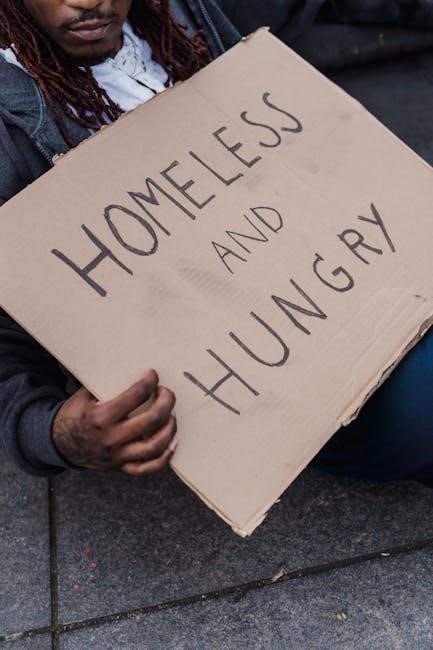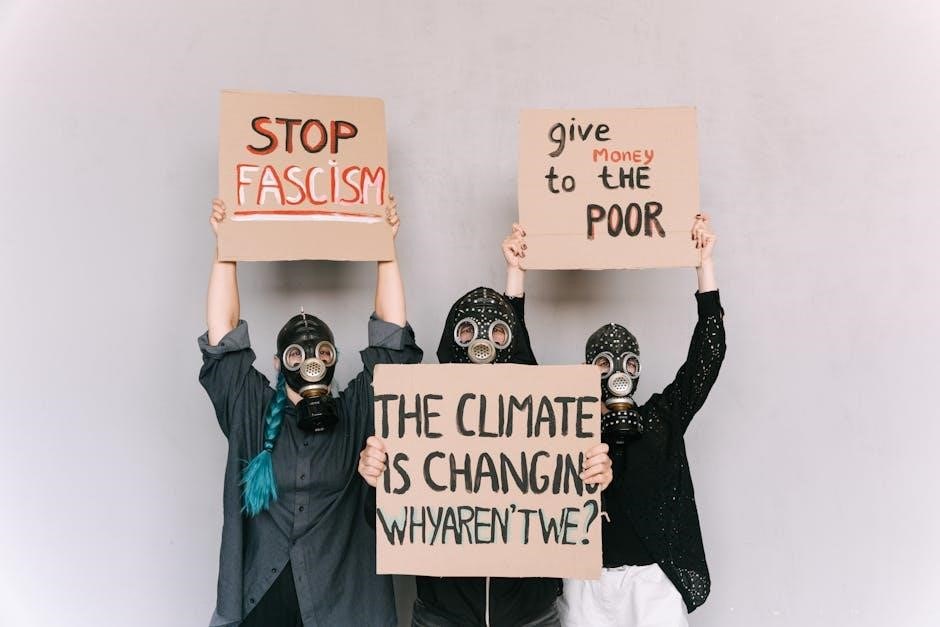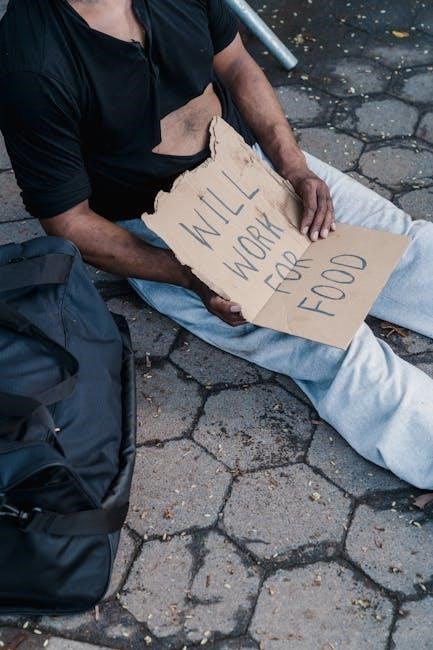Savage Inequalities by Jonathan Kozol is a critical examination of educational inequality in the U.S., focusing on urban schools and systemic disparities in resources and opportunities.
1.1 Overview of the Book
Savage Inequalities by Jonathan Kozol is a groundbreaking investigation into the disparities in U.S. education, exposing systemic inequities in funding, resources, and opportunities between urban and suburban schools. Through two years of observations and interviews, Kozol reveals how racial and economic segregation perpetuate inequality, leaving urban schools underfunded and inadequate; The book highlights the human cost of these inequalities, emphasizing the emotional and academic toll on students. Kozol’s work serves as a call to action for educational reform and justice.
1.2 Author Background: Jonathan Kozol
Jonathan Kozol is a renowned American educator, activist, and writer, best known for his critical analyses of public education. Born in 1936, Kozol graduated from Harvard University and began his career as a teacher in Boston’s inner-city schools. His experiences led him to advocate for educational equity, particularly in urban areas. Through works like Savage Inequalities, Kozol exposes systemic inequalities and challenges the status quo, earning him widespread acclaim for his commitment to social justice and educational reform.

Historical Context of Educational Inequality
The roots of educational inequality in the U.S. trace back to segregation and unequal funding systems, highlighted by the landmark Brown v. Board of Education case in 1954.
2.1 Segregation in U.S. Schools: Past and Present
Segregation in U.S. schools persists despite the 1954 Brown v. Board of Education ruling. Kozol argues that modern segregation is often indirect, driven by economic and racial divides. Urban schools predominantly serve minority students, while suburban schools remain largely white. This separation perpetuates inequality, as urban schools face underfunding and resource shortages, limiting opportunities for students. The legacy of segregation continues to affect educational outcomes, highlighting systemic failures in achieving true integration.
2.2 The Impact of the 1954 Brown v. Board of Education Decision
The Brown v. Board of Education ruling aimed to dismantle segregation in schools, yet its promise remains unfulfilled. Kozol highlights that while legal segregation ended, de facto segregation persists through economic and residential divides. Many urban schools remain predominantly minority, with inadequate resources. The decision’s intent to ensure equal education has been undermined by systemic inequalities, leaving a gap between legal victory and practical reality. This discrepancy underscores the ongoing struggle for educational equity in the U.S.
Key Themes in Savage Inequalities
Savage Inequalities explores racial and economic disparities, inadequate funding, and the human cost of inequality, highlighting systemic neglect and the urgent need for educational reform.
3.1 Racial and Economic Disparities in Education
Kozol reveals how racial and economic disparities perpetuate educational inequality, with urban schools facing underfunding, outdated resources, and overcrowded classrooms compared to suburban counterparts. These systemic inequities reflect broader societal issues, where marginalized communities struggle to access equal opportunities. The book underscores how these disparities affect student outcomes, reinforcing cycles of poverty and limiting future prospects for many children.
3.2 The Role of Funding in Educational Inequality
Kozol highlights how funding disparities exacerbate educational inequality, with urban schools often receiving significantly less funding than suburban schools due to reliance on local property taxes. This results in inadequate facilities, outdated resources, and a lack of qualified teachers in underfunded districts. The book emphasizes how such systemic financial inequities perpetuate cycles of poverty and limit opportunities for students in underserved communities, underscoring the need for equitable funding solutions to address these disparities.

Urban vs. Suburban Schools
Savage Inequalities reveals stark contrasts between urban and suburban schools, highlighting disparities in funding, facilities, and teacher quality. Urban schools often struggle with inadequate resources, while suburban schools benefit from greater investments, perpetuating systemic inequities in education. Kozol’s observations underscore the profound impact of these differences on student opportunities and outcomes, emphasizing the need for equitable solutions to bridge the gap.
4.1 Differences in Resources and Facilities
Kozol highlights significant disparities in resources between urban and suburban schools. Urban schools often struggle with outdated textbooks, limited technology, and inadequate infrastructure, while suburban schools enjoy modern facilities, advanced equipment, and ample funding. These differences create unequal learning environments, perpetuating systemic inequities. Kozol’s observations reveal how resource gaps directly impact student opportunities, underscoring the need for equitable solutions to address these glaring disparities in America’s education system.
4.2 Teacher Quality and Morale in Urban Schools
Kozol sheds light on the challenges faced by teachers in urban schools, including low morale, high turnover rates, and limited support. Many urban schools struggle to attract and retain experienced educators due to poor working conditions, insufficient resources, and lower pay compared to suburban schools. This disparity perpetuates a cycle of inequality, as students in urban areas often receive less effective instruction. Kozol emphasizes the need for systemic changes to address these issues and improve teacher quality in underserved communities.

The Human Cost of Inequality
Kozol highlights the emotional and mental toll of inequality on students, revealing feelings of hopelessness, anxiety, and despair that stem from inadequate resources and systemic neglect.
5.1 Student Experiences and Hope
Kozol vividly portrays students’ resilience amidst inequality, capturing their hope and innocence. Despite facing harsh realities, children exhibit mischievousness and wisdom, embodying potential often stifled by systemic neglect. Their stories reveal a fragile balance between optimism and despair, underscoring the human cost of educational disparity. Through their eyes, Kozol illustrates the profound impact of inequality on young lives and the urgent need for change to preserve their hope and future opportunities.
5.2 Mental Health and Emotional Distress
Kozol highlights the profound emotional toll of inequality on students, revealing struggles with anxiety, depression, and school avoidance. The lack of resources and systemic neglect exacerbate mental health challenges, leaving many students feeling isolated and hopeless. Teachers and families often witness this distress firsthand, underscoring the urgent need for systemic change to address these disparities and provide adequate support for affected youth.

Legal and Policy Failures
Savage Inequalities reveals how legal rulings and policies have failed to address educational disparities, perpetuating inequality and limiting opportunities for marginalized students in underfunded schools.
6.1 Inadequate Implementation of Educational Reforms
The failure to effectively implement educational reforms has worsened inequality, as seen in Savage Inequalities. Despite landmark rulings like Brown v. Board of Education, systemic disparities remain. Kozol highlights how policies often lack enforcement, leaving underserved schools without adequate resources. The gap between legislative intent and practical execution underscores the entrenched challenges in achieving equity. This inconsistency perpetuates unequal opportunities, disproportionately affecting marginalized students and communities, as Kozol vividly documents through his observations of urban schools.
6.2 The Role of Property Taxes in School Funding
In Savage Inequalities, Kozol critiques the reliance on property taxes for school funding, which perpetuates inequality. Wealthier districts with higher property values fund better schools, while poor areas struggle with limited resources. This system creates stark disparities in educational opportunities, as highlighted by Kozol’s comparisons of urban and suburban schools. The reliance on local property taxes ensures that economic segregation directly impacts education, perpetuating cycles of disadvantage for marginalized communities.
Solutions and Calls to Action
Kozol advocates for equitable funding, national reforms, and community engagement to address educational inequality, urging policymakers and citizens to prioritize justice and opportunity for all students.
7.1 Addressing Systemic Inequalities
Kozol emphasizes the need to dismantle systemic inequities by restructuring school funding tied to property taxes, ensuring equitable resource distribution, and implementing policies that prioritize underserved communities. He calls for comprehensive national reforms to address racial and economic segregation in schools, advocating for accountability and sustained commitment to creating a fair educational system for all students, regardless of their background or location.
7.2 The Importance of Advocacy and Awareness
Advocacy and awareness are crucial in addressing educational inequalities, as highlighted in Savage Inequalities. By shedding light on systemic disparities, Kozol encourages public pressure for reform. Raising awareness about funding inequities and segregation can lead to policy changes and equitable resource distribution. Kozol argues that societal transformation begins with exposing these issues, emphasizing the need for collective action to ensure all students receive a fair and just education, regardless of race or socioeconomic status;
Critical Reception and Impact
Savage Inequalities received widespread acclaim for its blunt portrayal of educational disparities, influencing reforms and sparking national conversations about inequality in U.S. schools.
8.1 Reviews and Praise for the Book
Savage Inequalities garnered widespread critical acclaim, with reviewers praising Kozol’s vivid storytelling and unflinching portrayal of educational inequities. Many hailed it as a powerful call to action, spotlighting systemic failures and the resilience of students and teachers in underfunded schools. The book’s emotional depth and moral urgency earned it recognition as a landmark work in educational literature, resonating with educators, policymakers, and the general public alike.
8.2 The Book’s Influence on Educational Reform
Savage Inequalities sparked significant discussions on educational reform, highlighting systemic inequities and advocating for fair funding models. Kozol’s work influenced policymakers and educators, prompting reevaluations of school finance systems and resource allocation. While reforms were slow, the book remains a catalyst for advocacy, inspiring efforts to address racial and economic disparities in education. Its impact continues to be felt in ongoing debates about equity and access in U.S. public schools.
Study Guide and Analysis
Savage Inequalities study guides offer detailed chapter summaries, key quotes, and analysis, helping readers grasp the book’s themes and arguments about educational inequality in America.
9.1 Chapter Summaries and Key Quotes
Study guides for Savage Inequalities provide detailed chapter summaries, highlighting Kozol’s key arguments about educational inequality. These summaries encapsulate his observations of urban schools, revealing stark disparities in resources and opportunities. Key quotes, such as Kozol’s poignant reflections on the hope and resilience of students, underscore the emotional and systemic challenges faced by marginalized communities. These resources offer insights into the book’s themes, aiding readers in analyzing its impact and relevance to ongoing educational reform efforts.
9.2 Discussion Questions and Essay Topics
- How do funding disparities between urban and suburban schools impact educational outcomes?
- What role do race and social class play in perpetuating educational inequality?
- Analyze Kozol’s argument that schools are more segregated now than in 1954.
- Discuss the emotional and mental health challenges faced by students in underfunded schools.
- Propose solutions to address systemic inequalities in education.
- Examine the impact of property taxes on school funding and how this affects urban vs. suburban schools.
Kozol’s work exposes deep educational inequalities, urging systemic change and continued advocacy for equity, justice, and much-needed reform in America’s schools.
10.1 The Legacy of Savage Inequalities
Jonathan Kozol’s Savage Inequalities has left a lasting impact on discussions about educational justice. Its vivid portrayal of racial and economic disparities in U.S. schools continues to inspire advocacy and reform efforts. By exposing systemic inequalities, the book has challenged policymakers and educators to address the root causes of educational injustice. Kozol’s work remains a powerful call to action, emphasizing the need for equitable resources and opportunities in urban schools. Its legacy endures as a critical voice for marginalized communities.
10.2 Continuing the Fight for Educational Equality
Savage Inequalities underscores the ongoing struggle for educational equity. Kozol’s work highlights the need for systemic change, urging policymakers to address funding disparities and segregation. Advocacy efforts must persist to ensure equal opportunities for all students; By raising awareness and promoting actionable solutions, the fight for educational equality continues, inspired by Kozol’s compelling narrative and commitment to justice. The book remains a vital resource in this enduring battle for a fair and inclusive education system.